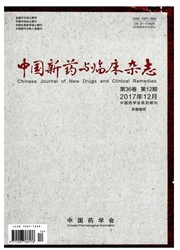

 中文摘要:
中文摘要:
目的探讨3T3-L1脂肪细胞水通道蛋白7(AQP7)的表达对胰岛素信号通路的影响,寻求改善胰岛素抵抗的新途径。方法体外培养3T3-L1脂肪细胞,以油红O染色鉴定分化成熟的脂肪细胞。以肿瘤坏死因子-α(TNF-α)处理脂肪细胞,检测葡萄糖代谢能力以及培养基中甘油浓度的变化;同时分别用荧光定量聚合酶链反应(Real-time PCR)和蛋白免疫印迹法(Western Blot)分析AQP7的表达水平。以腺病毒为载体高表达AQP7,检测胰岛素信号通路上胰岛素受体底物1(IRS-1)、蛋白激酶B(PKB)及其磷酸化蛋白水平的改变,从而阐明AQP7表达与胰岛素抵抗的关系。用SPSS 17.0软件进行统计学分析,两组计量资料的比较用独立样本t检验,多组计量资料的比较用单因素方差分析。结果 TNF-α作用分化成熟的脂肪细胞24 h构建胰岛素抵抗模型,与空白对照组比较,葡萄糖代谢水平下降50%,甘油浓度减少35%,而AQP7 m RNA及蛋白水平分别下调了75%和28%,差异均有统计学意义(P〈0.01,P〈0.05)。在胰岛素抵抗状态下,胰岛素刺激下的PKB磷酸化蛋白(p-PKB)、IRS-1酪氨酸632磷酸化蛋白(p-tyr632)及IRS-1总蛋白表达受到抑制,而IRS-1丝氨酸307磷酸化蛋白(p-ser307)异常升高,差异均有统计学意义(P〈0.05)。以腺病毒为载体转染脂肪细胞高表达AQP7,随着AQP7表达上调,可逆转TNF-α的这些作用。结论 AQP7可能参与胰岛素抵抗的分子机制,高表达AQP7对改善胰岛素抵抗的基因治疗有一定的指导意义。
 英文摘要:
英文摘要:
Objective To explore the effects of aquaglyceroporin 7(AQP7) on insulin signaling path way in 3T3-L1 adipocyte and to find a newway to improve insulin resistance. Methods After 3T3-L1 pre-adipocytes were cultured in vitro, then the fully differentiated mature 3T3-L1 adipocytes were identified with oil red O staining. The adipocytes were treated with TNF-α, the insulin resistance and glycerin level were measured. The real-time PCR and western blot assays were used to analyze the m RNA and protein expression levels of AQP7. Adenovirus overexpression AQP7(Ad-AQP7) vector was constructed and transfected to mature adipocytes. The expression levels of IRS-1, PKB and their phosphorylated proteins in insulin signaling pathway were measured. The t test and ANOVA were used to analyze the data, and the used software was SPSS17.0. Results After 3T3-L1 preadipocytes were with TNF-α for 24 h, the insulin resistance model was constructed. As compared with control group, the levels of glucose metabolism and glycerol release in insulin resistance group decreased by 50% and 35%, respectively; while the m RNA and protein expression levels of AQP7 significantly decreased by 75% and 28%, respectively(P〈0.01 or P〈0.05). Under insulin resistance condition, the expression of the phosphorylated PKB(p-PKB), the IRS-1 tyrosine 632 phosphorylation protein(ptyr632) and total IRS-1 protein stimulated by insulin was inhibited; but the expression of IRS-1 serine 307 phosphorylation protein(p-ser307) significantly enhanced(P〈0.05). When the high expression of AQP7 in adipocytes was transfected by adenovirus vector, the effects of TNF-α could be reversed. Conclusion AQP7 may be involved in the molecular mechanism of insulin resistance, and the high expression of AQP7 may be helpful for gene therapy to improve insulin resistance
 同期刊论文项目
同期刊论文项目
 同项目期刊论文
同项目期刊论文
 期刊信息
期刊信息
